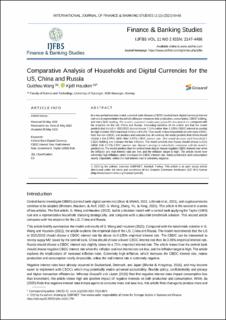| dc.contributor.author | Wang, Guizhou | |
| dc.contributor.author | Hausken, Kjell | |
| dc.date.accessioned | 2023-03-15T14:58:25Z | |
| dc.date.available | 2023-03-15T14:58:25Z | |
| dc.date.created | 2022-05-29T00:10:13Z | |
| dc.date.issued | 2022 | |
| dc.identifier.citation | Wang, G., & Hausken, K. (2022). Comparative Analysis of Households and Digital Currencies for the US, China and Russia. International Journal of Finance & Banking Studies (2147-4486), 11(2), 69-86. | en_US |
| dc.identifier.issn | 2147-4486 | |
| dc.identifier.uri | https://hdl.handle.net/11250/3058564 | |
| dc.description.abstract | In a two-period decision model, a central bank chooses a CBDC (central bank digital currency) interest rate and a representative household allocates resources into production, consumption, CBDC holding, and non-CBDC holding. The model’s analytical results and a plausible benchmark are compared with the empirics for the US, China and Russia. Interesting novelties of the article are that the model predicts that the US in 2021/2022 should choose rather than 0.125% CBDC interest to combat its high October 2021 empirical inflation of 6.2%. That would induce households to hold more CBDC, hold less non-CBDC, and produce and consume less. In contrast, the model predicts that China should choose a low rather than CBDC interest rate. That would decrease each household’s CBDC holding and increase the low inflation. The model predicts that Russia should choose rather than CBDC interest rate. Russia’s strategy is remarkably consistent with the model’s predictions. The model predicts that the central bank should choose negative CBDC interest rate when the inflation and real interest rate are low, and the inflation target is high. The article shows how extremely high inflation, which increases the CBDC interest rate, makes production and consumption nearly impossible, unless the real interest rate is extremely negative. | en_US |
| dc.language.iso | eng | en_US |
| dc.publisher | SSBFNET | en_US |
| dc.rights | Navngivelse 4.0 Internasjonal | * |
| dc.rights.uri | http://creativecommons.org/licenses/by/4.0/deed.no | * |
| dc.title | Comparative Analysis of Households and Digital Currencies for the US, China and Russia | en_US |
| dc.type | Peer reviewed | en_US |
| dc.type | Journal article | en_US |
| dc.description.version | publishedVersion | en_US |
| dc.rights.holder | The authors | en_US |
| dc.subject.nsi | VDP::Samfunnsvitenskap: 200 | en_US |
| dc.source.pagenumber | 69-86 | en_US |
| dc.source.volume | 11 | en_US |
| dc.source.journal | International Journal of Finance & Banking Studies (IJFBS) | en_US |
| dc.source.issue | 2 | en_US |
| dc.identifier.doi | 10.20525/ijfbs.v11i2.1790 | |
| dc.identifier.cristin | 2027914 | |
| cristin.ispublished | true | |
| cristin.fulltext | original | |
| cristin.qualitycode | 1 | |

